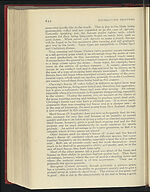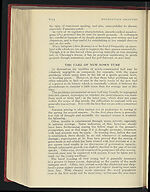1939-40
(681)
Download files
Complete book:
Individual page:
Thumbnail gallery: Grid view | List view

RECREATION GROUNDS
6
53
dark, glossy green. With some of the dwarfer types where the leaf
blade is not excessively broad the turf is reasonably dense. More-
over, very clean seed, having good powers of germination, is usually
available. A serious disadvantage is its lack of ability to last in-
definitely when subject to close, intensive cutting, for under such
circumstances, the ground cover, which is never very close, quickly
decreases, leading to the invasion of local weeds.
Football pitches and sports grounds can usually be sown satis-
factorily with a mixture containing a high percentage of rye-grass ;
the mowing factor does not enter here so much and also because
that desirable fibre " mat " required to give resiliency in turf for
golf, and even for racing, is not so necessary in these cases. A good
deal is now being planted along the verges of newly-constructed
roads.
Many types of rye-grass are now available and find their way into
the cheaper mixtures. Seed houses introduce their own selections
generally for pasture work, but dwarf types more suitable for sports
turf are on the market also. Kent indigenous is a type which has
been raised now for some years, generally along with seed of wild
white clover, and " once-grown " seed is that taken from crops
sown with Kentish " Mother " seed, usually in other districts.
" Short seed " rye-grass seed, sieved out in the cleaning process,
has a higher bushel weight and gives more seeds per pound than
other sorts
in
commerce. Selections from Denmark and Sweden
can be obtained, and the best known type raised in this country is
the Welsh Plant Breeding Station strain " S.z3."
As a general utilitarian species for making turf not of the first
quality, Crested dog's-tail
(Cynosurus cristatus)
has much to com-
mend it. It will thrive equally well on light dry soils as on those
of a heavier class in wetter districts. Because its leaf blades tend
to lie flat on the surface they give a ground cover not usually looked
for in a broad-bladed grass ; the colour is always a deep fresh green,
even when other species die off naturally in the winter season. Seed
is supplied from N Ireland and New Zealand, and occasionally Kent,
with a high purity figure and good germination.
Rough-stalked meadow-grass
(Poa trivialis)
generally grows
fairly well, provided a fair proportion of other grasses are sown
with it to cover up the runners which it makes. Being susceptible
to drought, this grass, which frequently changes to a marked red
colour in a hot summer, can only be sown on soils with a sufficient
water supply. When closely looked for in turf it can be recognised
by the terminal glossy narrow shoot which becomes erect.
Annual meadow-grass
(Poa annua)
is quite comparable with the
best of the bents and fescues in respect of withstanding intense
defoliation. It is the commonest constituent of the vast majority
of lawns, bowling greens, golf greens and sports grounds in this
country. This is explained by its habit of flowering and seeding
under the keenest cutting and its powers of rapid colonisation.
Some of the serious objections to
a Poa
turf are poor yellow colour
in early spring, the rather whiteish colour in the summer during
6
53
dark, glossy green. With some of the dwarfer types where the leaf
blade is not excessively broad the turf is reasonably dense. More-
over, very clean seed, having good powers of germination, is usually
available. A serious disadvantage is its lack of ability to last in-
definitely when subject to close, intensive cutting, for under such
circumstances, the ground cover, which is never very close, quickly
decreases, leading to the invasion of local weeds.
Football pitches and sports grounds can usually be sown satis-
factorily with a mixture containing a high percentage of rye-grass ;
the mowing factor does not enter here so much and also because
that desirable fibre " mat " required to give resiliency in turf for
golf, and even for racing, is not so necessary in these cases. A good
deal is now being planted along the verges of newly-constructed
roads.
Many types of rye-grass are now available and find their way into
the cheaper mixtures. Seed houses introduce their own selections
generally for pasture work, but dwarf types more suitable for sports
turf are on the market also. Kent indigenous is a type which has
been raised now for some years, generally along with seed of wild
white clover, and " once-grown " seed is that taken from crops
sown with Kentish " Mother " seed, usually in other districts.
" Short seed " rye-grass seed, sieved out in the cleaning process,
has a higher bushel weight and gives more seeds per pound than
other sorts
in
commerce. Selections from Denmark and Sweden
can be obtained, and the best known type raised in this country is
the Welsh Plant Breeding Station strain " S.z3."
As a general utilitarian species for making turf not of the first
quality, Crested dog's-tail
(Cynosurus cristatus)
has much to com-
mend it. It will thrive equally well on light dry soils as on those
of a heavier class in wetter districts. Because its leaf blades tend
to lie flat on the surface they give a ground cover not usually looked
for in a broad-bladed grass ; the colour is always a deep fresh green,
even when other species die off naturally in the winter season. Seed
is supplied from N Ireland and New Zealand, and occasionally Kent,
with a high purity figure and good germination.
Rough-stalked meadow-grass
(Poa trivialis)
generally grows
fairly well, provided a fair proportion of other grasses are sown
with it to cover up the runners which it makes. Being susceptible
to drought, this grass, which frequently changes to a marked red
colour in a hot summer, can only be sown on soils with a sufficient
water supply. When closely looked for in turf it can be recognised
by the terminal glossy narrow shoot which becomes erect.
Annual meadow-grass
(Poa annua)
is quite comparable with the
best of the bents and fescues in respect of withstanding intense
defoliation. It is the commonest constituent of the vast majority
of lawns, bowling greens, golf greens and sports grounds in this
country. This is explained by its habit of flowering and seeding
under the keenest cutting and its powers of rapid colonisation.
Some of the serious objections to
a Poa
turf are poor yellow colour
in early spring, the rather whiteish colour in the summer during
Set display mode to:
![]() Universal Viewer |
Universal Viewer | ![]() Mirador |
Large image | Transcription
Mirador |
Large image | Transcription
| Games and sports in the army > 1939-40 > (681) |
|---|
| Permanent URL | https://digital.nls.uk/248755053 |
|---|
| Description | 'Games and Sports in the Army' was an annual publication produced by the British War Office between the 1930s and 1960s. This included the Second World War. It outlines the rules and regulations for games and sports played by members of the armed forces. It features names and photographs of team members, and examples of contemporary advertising. |
|---|---|
| Shelfmark | GWB.52 |

